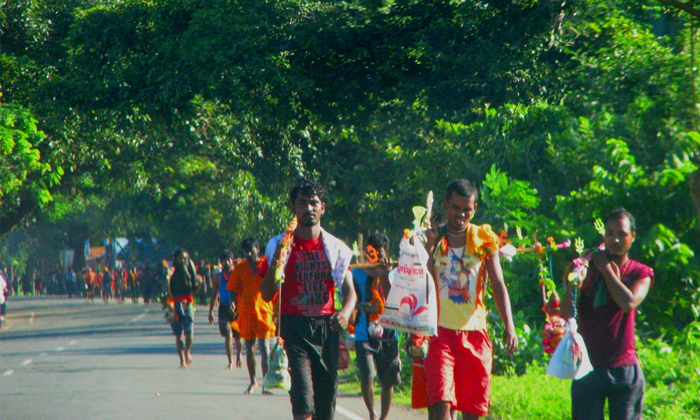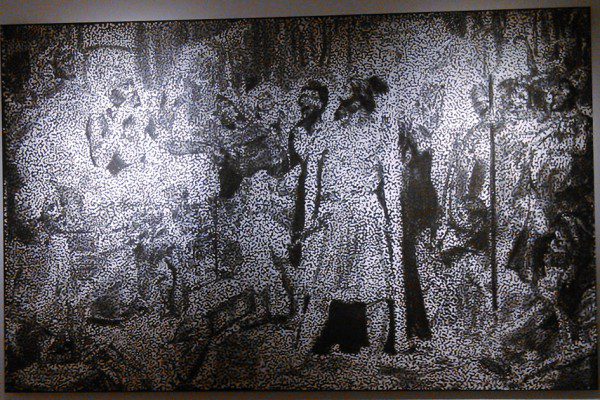Like a swarm of locusts, they invade your town, your homes, destroying everything in their path. Creating chaos and panic, they fear no one. Travelling on bikes, jeeps, cars, trucks, they flaunt brute power.
Putting on saffron shorts/vests and chanting ‘Bhole’ gives them legitimacy to break all rules, laws and even bones. Meet the new age pilgrims — Kanwariyas. Embracing saffron, lakhs of these men congregate on the banks of Ganga in Haridwar and Rishikesh in Uttarakhand to collect holy water that would be consecrated at the lingams in their hometowns.
This is their ode to the Shiva. Ironically, much of that holy water is barely holy as it carries excreta of the same individuals who have on the pretext of religion come to have a good time in this pristine landscape. Parking themselves next to the river, they excrete all over the riverbanks making it extremely difficult for people to even walk. The air is pregnant with stench of human waste and every spell of rain brings joy to the locals as rainwater cleans the shit that is spread all over.
It is the locals who are at the receiving end of this crass commercialised religious congregation, confiding themselves indoors; they avoid the bitterness and machismo these shiva bhakts display. Young girls are not allowed to go out and are usually packed off to relatives to avoid any unwanted incident. If anyone does dare to step out of the house, she is humiliated with derogatory comments, gestures and sometimes even groping. A group of foreigners were being touched by every man on the street in Haridwar, until police came to their rescue.
Except for Kanwars, there is hardly any activity in the city, the shops are shut out of fear as they routinely loot and indulge in vandalism. Even the basic necessities like milk and bread are hard to come by. These towns are under the siege of the saffron generation that is out to seek and destroy. A small affair till the 1990s, Kanwar yatras have grown in popularity over the years. Earlier, only a handful of sadhus would take this treacherous journey on foot to collect water. During the Yatra, Kanwars would carry single bamboo pole with two water containers dangling from opposite ends. The kanwar throughout his journey on foot would balance the pole on one or both shoulders and the containers should never touch the ground. These norms were hard to follow and with greater income at their disposal, people started giving preference to bikes, trucks and other forms of transportation.
Once the monsoon sets in, a wave of saffron engulfs the entire region. Perched on top of buses, crowded in trains, they don’t pay a penny for this religious tourism. The police and authorities become mere spectators to avoid any confrontation that could turn ugly. Besides, who would like to get into a brawl with ‘rowdy’ Kanwariyas? Several instances of Kanwariyas destroying public property have been witnessed in the past. They operate in packs and a small scuffle soon leads to a serious law and order situation. Known to carry firearms, baseball bats, lathis, Kanwars take little time before unleashing their fury on who-so-ever questions their behaviour.
With shades of subaltern youth movement, Kanwar yatra is gaining popularity amongst unemployed youth mostly, who some believe seek respect of the society by indulging in something so godly. On the margins of the society, they tend to use this opportunity to claim reverence. Plus, where else would you be allowed a free reign with no fear whatsoever.
Also, they have benefitted from this 8 per cent economic growth and can now afford to use motorcycles to get that adrenalin rush. The ones who are better off manage to hire trucks, packing them with generators and massive speakers and a few makeshift beds. In this party mode, most Kanwars drink till late in the night and then dance in their undergarments on songs that have been lifted from some Bollywood hits. Bhajans on chikni chameli and other item songs are received with great fanfare. Bikers would stop to break into a jiggy before heading towards their party spot.
Interestingly, Kanwars have managed to impress the rightwing organisations with their sheer numbers. Outfits like Vishwa Hindu Parishad and others ensure that Kanwars are provided better food and services like women cleaning their feet, among others at their respective camps. Thousands of such camps are spread across these highways that connect Haridwar with Delhi and other states. It must be in their sinister agenda to use these unruly men to their advantage at an opportune moment. This trend should disturb the administration and the government as rightwing forces could unleash these men to create havoc in the region. This swarm of locust could soon be eating away the secular fabric of the nation.
These whiskey guzzling, sex starved, ignorant, marginalised, depressed souls for now could be treated as a socio-economic phenomenon, but when it begins to show signs of political assertion, the government would have more to worry about.
Till then, let Kanwars rule the roost and enjoy this religious tourism that is slowly poisoning and polluting these two cities that were once the hallmark of spirituality and serenity. And let the river die a shitty death!
PS: I have great admiration and respect for Kanwars who are untouched by this commercialized jamboree and walk barefoot for hundreds of kilometers. Their bandaged and blood soaked feet are a testimony of the arduous journey they undertake every year to appease Shiva. Gods and men must take a bow to this great sacrifice.


